This is a belated post about my experiences leading up to my World Cup debut last week in Ostersund, Sweden.
Looking out the window… there are men setting up a television camera on a raised platform. They angle it so it will catch racers hammering over the course’s last uphill. Volunteers are unraveling sponsor signs, stretching them over large wooden frames and inflating them into balloon arches. A media truck pulls into the stadium and unfolds a jumbotron. It comes to life broadcasting a test screen of technicolor blocks. Towering spotlights gaze down, spilling brilliant white light over every activity and night transforms into a bright day. Like worker ants, wax techs haul a dozen pairs of skis at a time to the course using wooden carriers. They swarm around and around the tracks, always testing, always wondering. Which is the best ski? The most suitable grind? The fastest wax? We still have a couple days before our first race, but looking out the window at all this activity, I already feel nervous.
In the days leading up to the races, we are bombarded with schedules. I’m accustomed to having specific practice and rifle zeroing times, but we also are given designated times to report in for ski testing and course tactic discussions. Outside of training, we must fit in visits to equipment control and the media center where we get headshots and photos for equipment sponsors. Life suddenly becomes more complicated, but in a good way. Our staff is three times bigger than the staff I’m used to having on the IBU Cup or European Championship level. They all tell me that I need to act needy and that I shouldn’t hesitate to let them know if I could use any help with equipment, training, recovery, health issues, etc. I’m a little overwhelmed.
One of the first things our team takes care of is passing through equipment control. When we arrive, the German women are already there. I watch as the IBU officials write each woman’s names and country on a sheet of white paper and then take a photograph of their rifle next to the sheet. I suddenly realize what name is on the sheet of the girl standing in front of me… Neuner. I stare for a moment. This is Magdalena Neuner, the German national celebrity, one of the most talented biathletes in the world, and she is standing right in front of me. I don’t know what I expected, but it somehow surprises me that she looks so human and normal. I remember something my dad, a former XC ski racer, told me a few years back: “The Europeans may be fast, but they put their pants on in the morning the same way you do. There is nothing magic about them.” The shock passes.
Later that day, we each test our skis one-on-one with a wax tech. I don’t have very much experience with ski testing and I’ve always struggled to feel small differences in glide. In order to figure out which pair glides the most freely, I wear a different ski on each foot and imagine that there is sandpaper on the bottom of my skis. Then I ask myself which sandpaper feels less gritty. The techs give us about a minute to feel out each combination and then it’s time to compare results and switch to a new combination. The differences between skis sometimes feel so insignificant, it is easy to second guess yourself. After practice, one of the coaches said he heard that I “did well” during ski testing. I couldn’t help but wonder whether that first ski testing exercise was more a test of my own testing abilities than a test of my skis.
On the first day of “official training” I put on my skis and head out into the brightness of the stadium. There are already fans hanging out behind the course fences and snapping pictures as athletes glide by. We are on display. Everything I’ve experienced in the last 48 hours feels so foreign and so far from biathlon as I have known it. Even the shoot mats seem to glow; I find their neon green color distracting as I lay down to zero my rifle. Somehow the essence of biathlon has been buried under all the flashy preparations for the World Cup. I must rediscover it.
Following the first race of the season, an IBU Cup that I felt pretty good about, I had a discussion with our team doctor, Ed Merrins. “You wore a smile in the start pen before the race,” he observed. “And you were wearing one after.” Smiling and keeping a light and free attitude works well for me in races. Sometimes I weigh myself down with my own expectations (or those of other people). When that happens, I don’t have as much fun and I don’t think I can tap into my full potential. With that in mind, I decided to force a smile during training and racing the next few days.
Back to that first official practice… After zeroing my rifle, I ski out onto the loop, away from the craziness of the stadium. I follow a trail of spotlights fading into the far reaches of the course. The skis are fast and familiar under my feet and I feel like I’m flying. This is the skiing I know. I travel around the loop, playing with different tempos on the hills, throwing in a few playful hop skate steps. Then I accelerate into the track’s sharpest downhill S-turn and thrill in the adrenaline rush. Returning to the range, I pick up my rifle and drop onto a shooting point. The targets look just like they always do: small dots 50 meters away, and all I have to do is breathe consistently and squeeze the trigger gently. I can do this. It’s just shooting. All of this is just shooting and skiing. Nothing has changed really. I wear a genuine smile on my face and revel in the joy of simply being here.
Fast forward to race day… I step out our front door to head down to the stadium for my zero. Immediately I taste wood smoke on the air from the volunteers’ warming fires. As I walk down through the wax cabins and across the warm-up track, a cool wind brushes against my cheek and I shiver. This is it; I’m about to race in a World Cup. Nothing can get in the way now. Or can it? I have a sudden vision of tripping on the slippery stairs ahead and hurting myself in a freak accident. But I walk down the stairs and I don’t slip. Minutes later, I pass through the stadium entrance tunnel, rifle on my back and skis in hand, and I emerge into the glaring light. It’s time to warm-up.
At the start of the warm-up hardly anybody is in the stands, but they fill up by race time when I make my way to starting chute. It funnels racers one by one into the inflated arch containing the start gate. For thirty seconds, I get this quiet balloon cave entirely to myself. I wave and smile at the camera like I’ve seen so many other athletes do, although I doubt the TV will show an unknown rookie. All the top dogs are already battling it out on the course. I don’t fear the television cameras tonight; I don’t believe they will bother showing any footage of me. I watch the seconds tick by on the start clock. The light turns green and my start time appears. I shoot through the timing wand and the race has begun.

Photo: US Biathlon/NordicFocus.com
Just ski, I tell myself. It’s no different than training. My mind is clear and I react to the terrain, switching between V2, V2 alt, and V1 techniques as the hills and snow conditions dictate. I think about picking up my tempo around corners and accelerating over the top of each hill. After a couple minutes, I remember that this is a 15 km race and I should probably pace myself, but I’m closing in on a pack just ahead. I’m still fresh and the skiing feels easy. I weave through to the front of the pack and settle in behind a red, yellow, and black uniform of the German team. As we start up the longest climb of the loop, I match the German girl’s rhythm and we cruise up the hill together. Before I realize it, we are already back in the stadium. I check the wind, drop onto a shooting mat, load a clip, and take 5 shots without being fully aware of what I’m doing. It’s only then that the excitement creeps in- I hit all of them! I just cleaned the first stage of my World Cup career! With no penalties yet, I begin lap 2.

Photo: US Biathlon/NordicFocus.com
Sometimes, it is best to not know certain things. Throughout the entire race, I heard the US coaches and staff cheering for me at different points along the course. They were telling me that I was having a fantastic “running time” (i.e. ski time in European lingo), but they chose not to tell me that I was in third place after that first shooting stage. I also found out after the race that the German girl I skied with was in fact Neuner (which had a lot to do with the fast split time) and that I did get a lot of TV time because I was near her. I’m not exactly sure what would have happened had I known any of these things during the race. I likely would have slowed down because I didn’t believe I belonged with Neuner and I probably would have felt a lot of pressure on the shooting range and missed more targets. As it was, I still managed to miss a bunch of targets in the last three shooting stages, earning myself seven minutes in penalty time. I finished in 45th place (out of almost 100) with one of the top 25 ski splits. This far surpassed my own expectations. The race was a blast and I’m glad I made the “mistake” of skiing with Neuner and going out too hard in the first lap. The experience boosted my confidence and showed me what is possible.

Photo: US Biathlon/NordicFocus.com



